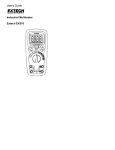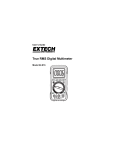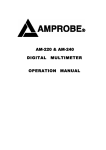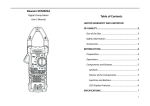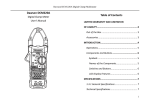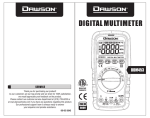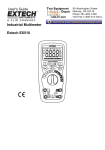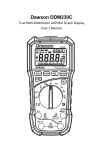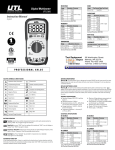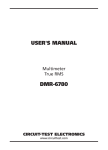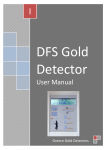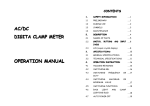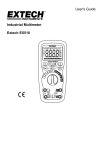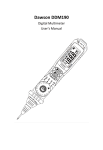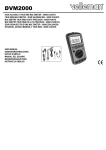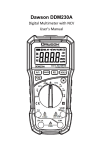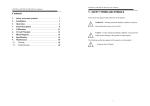Download Manual
Transcript
DCM730 Digital Clamp Meter User’s Manual Table of Contents LIMITED WARRANTY AND LIMITATION OF LIABILITY........................1 Out of the Box..................................................1 Safety Information ...........................................2 INTRODUCTION ......................................4 Components and Buttons..................................6 Names of the Components................................6 Switches and Buttons.......................................9 Display..........................................................10 USING THE METER.................................11 Display Hold...................................................11 Manual Mode..................................................11 MAX/MIN Display............................................11 Switching Between Functions..........................11 Backlight and clamp light .... . ...........................12 Auto Power Off ..............................................12 Measurement Preparation ..............................12 AC Current ....................................................13 Table of Contents AC/DC Voltage ..............................................13 Frequency and Duty Cycle..............................14 Resistance....................................................16 Diodes..........................................................17 Continuity......................................................17 Capacitance..................................................18 Non-Contact Voltage (NCV)............................18 SPECIFICATIONS..................................19 General Specifications...................................19 Technical Specifications.................................20 MAINTENANCE.....................................24 General Maintenance.....................................24 Battery Replacement ..................................25 Test Leads Replacement ................................25 Contact Dawson....................................25 LIMITED WARRANTY AND LIMITATION OF LIABILITY This instrument from Dawson Tools Inc. will be free from defects in workmanship and material for three years from the date of original purchase. This warranty does not cover defects resulting from damage caused by the user such as drops, neglect, misuse, unauthorized alteration, usage outside of specified conditions, contamination, or improper repair/maintenance. To receive service on the instrument if it becomes necessary during the warranty period, contact your nearest Dawson authorized service center at (800) 898-6991 or visit www.DawsonTools.com to obtain a return authorization (within the US only). A return authorization is necessary before returning any instrument to Dawson; no service will be provided without a return authorization. The user is responsible for properly packing the unit and charges such as shipping, freight and insurance charges. The extent of Dawson's liability is limited solely to the repair/replacement of the instrument. The above warranty in its entirety is inclusive and no other warranties, written or oral, are expressed or implied. Safety Information WARNING: TO REDUCE THE RISK OF FIRE, ELECTRICAL SHOCK, DAMAGE TO THE INSTRUMENT OR PERSONAL INJURY, PLEASE FOLLOW THE SAFETY INSTRUCTIONS DESCRIBED IN THE USER MANUAL. WARNING: TO ENSURE SAFE OPERATION AND LIFE OF THE METER, DO NOT PLACE THE METER IN ANY ENVIRONMENT WITH HIGH PRESSURE, HIGH TEMPERATURE, DUST, EXPLOSIVE GAS OR VAPOR. Safety Symbols Symbol Conforms to relevant European Union directives Out of the Box Check the meter and accessories thoroughly before using the meter. Contact your local distributor if the meter or any components are damaged or malfunction. Dangerous voltage may be present. Double Insulation, Protection Class II. Accessories • Test leads • User’s manual • 1.5V AAA battery • Case 1pc 1pc 3pc 1pc 01 Definition Important safety message C CONFORMS TO UL STD. 61010-1, IEC 61010-2-032 CERTIFIED TO CSA STD. C22.2 No. 61010-1 and IEC 61010-2-032 02 This product has been tested to the requirements of CAN/CSA-C22.2 No. 61010-1, second edition, including Amendment 1, or a later version of the same standard incorporating the same level of testing requirements. Ground Warning Symbols WARNING: Risk of danger; important safety information. See User’s manual. CAUTION: Statement identifies conditions and actions that a failure to follow the instructions could result in false readings, damage the meter or the equipment under test. 03 Introduction Overview DCM730 is a portable, hand-held professional meter that measures AC/DC voltage, AC current, resistance, capacitance, diodes, continuity, frequency, duty cycle and non-contact voltage. This meter is easy to use with one hand, suitable for professional users or amateurs, and ideal for school or home use. Precautions: Users must follow standard safety instructions while using the meter: 1. Once the meter is out of the package, check for any damage to the meter before using. 2. Double check the meter to make sure all the components are in good condition. 3. Check the test leads before operation. Check the test leads for damage to the insulation or wires before use. 4. Use the original test leads included in the package for best performance and safety. If necessary, use compatible leads with same specifications as the originals. 5. Make sure to set the meter to the correct functions and measuring range. 6. Do not use the Meter on a circuit where the measuring range is over the capable range specified in the User’s manual. 7. Do not touch the tips of the test leads when performing measurement. 8. If the measurement is above 60V DC or 30V AC, make sure to keep fingers behind the barrier and finger guards. 9. Do not use the meter on a circuit if the voltage is above 600V. 04 10. In manual mode, if the value to be measured is unknown, start the meter in the maximum range and then adjust accordingly. 11. Remove the leads from the circuit first before switching between functions. 12. Disconnect power and discharge all capacitors before measuring resistance, capacitance, continuity or diodes. 13. Do not measure capacitance before the capacitors are discharged. 14. Do not operate the meter near explosive gas, vapor or dust. 15. Stop using the meter if the meter or test leads appear damaged or do not function properly. 16. Do not use the meter unless the battery case is securely fastened to the back of the meter. 17. Do not expose the meter to direct sunlight, heat, or moisture. 05 Components and Buttons Names of the Components 1.Current clamp 2.NCV indicator 3.Function button 4.Range button 5.Maximum/Minimum button 6.Display 7.Common jack (-) 8.Input jack (+) 9.Frequency/duty cycle button 10.Non-contact voltage button 11.Data hold/backlight button 12.Rotary switch 13.Clamp center 14.NCV sensor 15.Worklight 16.Test lead holder 17.Battery cover 18.Clamp trigger 19.Hook (to hang meter) 20.Test lead holder 06 14 1 13 15 20 12 2 16 19 11 3 18 WARNING ATTENTION 4 5 10 9 TO AVOID ELECTRICAL SHOCK, REMOVE TEST LEADS BEFORE OPENING BATTERY COVER. POUR ÉVITER TOUT CHOC ÉLECTRIQUE, RETIREZ LES CORDONS DE TEST AVANT D’OURVIR LA BATTERIE OU LE COUVERCLE DU FUSIBLE 600V CAT III DC1.5Vx4,SIZE AAA 6 C 7 8 07 08 17 Display Switches and Buttons FUNC button: to switch between functions. RANGE button: to switch to manual range. AUTO / button: to hold the reading or to turn on backlight. MAX-MIN REL DC µnF %Hz kMΩ mVA MAX/MIN button: to switch between max. and min. display. AC Hz% button: to switch between frequency and duty cycle. NCV button: to activate non-contact voltage detection. Rotary Switch: switch between measurement modes. INPUT: Input jack for measuring voltage, resistance, capacitance, diodes, continuity, frequency, duty cycle. COM: Common input jack. AC, DC AUTO MAX MIN H % mV,V A nF, µF Ω, kΩ, MΩ Hz, kHz, MHz 09 Alternating current, Direct current Diode, continuity Auto-range mode Maximum measurement Minimum measurement Auto power off Low battery Display hold Percentage (duty cycle) MilliVolt, Volt (voltage) Amp (current) Nanofarads, microfarads, millifarads Ohms, kilohms, megaohms Hertz, kilohertz, megahertz 10 Using the Meter Backlight and clamp light Display Hold • Hold / to turn on the display backlight; the backlight will stay on for 30 seconds before it automatically turns off. • To turn off the backlight manually, hold / again. • When the meter is in current mode, turning on the backlight will also activate the worklight, making it easier to use the clamp in dark areas. During measurement, press / to hold the current reading on the display. Press again to release the hold. Manual Mode • The default range in voltage and resistance modes is auto. To switch to manual range, press “RANGE” and the display switches to manual mode. Each press of the button increases the range and returns to the lowest range when pressed in the highest range. • Hold “RANGE” to switch back to auto-range. Note: In current mode, manual is the only mode available.In frequency and capacitance modes, only auto-range is available. MAX/MIN Display Press “MAX/MIN” to show the maximum value recorded since the button was pressed. Press “MAX/MIN” again to show the minimum value recorded since the button was pressed. Hold “MAX/MIN” to return the display to normal. Note: • The meter is set to manual mode when in Max/Min mode. • The meter cannot display Max/Min measurements when in frequency/duty cycle, capacitance, diode or continuity modes. Switching Between Functions • When the meter is in voltage mode, press “FUNC” to switch between DC and AC voltage. • When the meter is in diode/continuity mode, press “FUNC” to switch between them. 11 Note: • The meter uses an LED for a backlight; even though the backlight is set to turn off after 30 seconds, use only when necessary to conserve battery life. Auto Power Off • If the meter is not used for 15 minutes, the meter will turn itself off to conserve battery life. • To turn the meter back on after auto off, press “FUNC”. • To disable auto power off, hold “FUNC” while turning the meter on. Measurement Preparation • Make sure that when measuring current the current being measured does not exceed the range selected for an extended period of time. This can cause overheating and damage the meter. • When measuring in manual range and the value to be measured is unknown, start in the highest range and adjust the range as needed. • Make sure to turn the rotary switch to the proper position before connecting the leads to a circuit. • When connecting to a circuit, connect the black lead (COM jack) first before connecting the red lead (INPUT jack). Remove the leads in the opposite order when finished. 12 AC Current WARNING: TO AVOID ELECTRICAL SHOCK AND INJURY, PLEASE REMOVE TEST LEADS BEFORE MAKING CURRENT MEASUREMENTS. 1.Turn the rotary switch to the current position with the correct range. 2.Press the clamp trigger to open the clamp and insert the conductor to be measured. 3.Read the measured current value on the display. Note: • Measuring two or more conductors will cancel out readings. Only measure one conductor at a time. • For best results, keep the conductor in the middle of the clamp. • “ ”indicates the maximum input AC Current is 1000 A. AC/DC Voltage WARNING: USE CAUTION WHEN MEASUREING HIGH VOLTAGE CIRCUITS TO AVOID ELECTRICAL SHOCK AND INJURY. DO NOT MEASURE INPUT VOLTAGES HIGHER THEN 600V AC/DC. 1.Insert the black test lead into “COM” jack and red test lead into “INPUT” jack. 2.Turn the rotary switch to the V The default mode is DC voltage; press “FUNC” to switch to AC voltage if necessary; press “FUNC” to switch back to DC voltage. 2.Connect the test leads across the voltage source or load. 3.Read the measured voltage value on the display. 13 Note: • When measuring small voltage sources, the display will show unsteady readings until the leads are connected to the circuit. This is normal due to the high sensitivity of the meter. The meter will display the correct reading once the leads are connected to the circuit. • “ ”indicates the maximum input voltage is 600V DC/AC. In “mV” range, the maximum input voltage is 600mV DC/AC. • In the mV range, the meter will beep if the reading is greater than 600mV DC/AC. Frequency and Duty Cycle In Current Mode (A) WARNING: REMOVE THE TEST LEADS FROM THE METER WHEN PERFORMING A CURRENT MEASUREMENT WITH THE CLAMP TO AVOID ELECTRICAL SHOCK AND INJURY. 1.Turn the rotary switch to the current position with the correct range. 2.Press the clamp trigger to open the clamp and insert the conductor to be measured. 3.Press “Hz/%” button to measure frequency. 4.Press “Hz/%” again to measure duty cycle if necessary. 5.Read the measured frequency or duty cycle value on the display. 14 Note: • Measuring two or more conductors will cancel out readings. Only measure one conductor at a time. • “ ”indicates the maximum input current is 1000A AC RMS. • Frequency range is 10Hz~1kHz. When the frequency being measured is less than 10Hz or if the frequency is higher than 1kHz, the accuracy is not guaranteed. In Voltage Mode (V) WARNING: DO NOT MEASURE VOLTAGES OF MORE THAN 600V AC TO AVOID ELECTRICAL SHOCK AND INJURY. 1.Insert the black test lead into “COM” jack and red test lead into “INPUT” jack. 2.Turn the rotary switch to the V position. Press “FUNC” to switch to AC voltage. 3.Press “Hz/%” button to measure frequency. 4.Press “Hz/%” again to measure duty if necessary. 5.Connect the test leads across the voltage source or load. 6.Read the measured frequency or duty cycle value on the display. Note: • “ ”indicates the maximum input voltage is 600V AC RMS. • Frequency range is 10Hz~10kHz. When the frequency being measured is less than 10Hz or if the frequency is higher than 10kHz, the accuracy is not guaranteed. 15 In Hertz Mode (Hz) WARNING: DO NOT MEASURE INPUTS OF MORE THAN 250V AC TO AVOID ELECTRICAL SHOCK AND INJURY. 1.Insert the black test lead into “COM” jack and red test lead into “INPUT” jack. 2.Turn the rotary switch to the Hz position.The default mode is frequency; press “Hz%” to switch to duty cycle if necessary. 3.Connect the test leads across the voltage source or load. 4.Read the measured frequency or duty cycle value on the display. Note: • Frequency range is 10Hz~10kHz. When the frequency being measured is less than 10Hz or if the frequency is higher than 10kHz, the accuracy is not guaranteed. Resistance WARNING: TO AVOID ELECTRICAL SHOCK AND INJURY, TURN OFF POWER TO THE CIRCUIT AND DISCHARGE ALL CAPACITORS BEFORE MEASURING RESISTANCE. 1.Insert the black test lead into “COM” jack and red test lead into “INPUT” jack. 2.Turn the rotary switch to the Ω position. 3.Connect the test leads across the circuit to be tested. 4.Read the measured resistance value on the display. 16 Note: • If the resistance is too high or the test leads are disconnected, the display shows “OL”. • The meter may take several seconds to get a steady reading if the resistance being measured is more than 1MΩ. This is normal for high resistance circuits. Diodes 1. Insert the black test lead into “COM” jack and red test lead into “INPUT” jack. 2. Turn the rotary switch to the position.The default mode is diode mode. 3. Connect the red lead to the anode (+) and the black lead to the cathode (-). 4. Read the measured forward biased voltage drop on the display. Note: • If the leads are connected backwards or to an open circuit, the display will show “OL”. Continuity WARNING: TO AVOID ELECTRICAL SHOCK AND INJURY, TURN OFF POWER TO THE CIRCUIT AND DISCHARGE ALL CAPACITORS BEFORE MEASURING CONTINUITY. 1.Insert the black test lead into “COM” jack and red test lead into “INPUT” jack. 2.Turn the rotary switch to the position.Press “FUNC” to switch to continuity mode. 2.Connect the test leads across the circuit to be tested. 3.Read the measured resistance value on the display. 4.If the resistance is less than 50Ω, the meter’s buzzer will sound. 17 Note: If the resistance is higher than 600Ω or the leads are disconnected, the display shows “OL”. Capacitance WARNING: TO AVOID ELECTRICAL SHOCK AND INJURY, TURN OFF POWER TO THE CIRCUIT AND DISCHARGE ALL CAPACITORS BEFORE MEASURING CAPACITANCE. 1.Insert the black test lead into “COM” jack and red test lead into “INPUT” jack. 2.Turn the rotary switch to the position. 3.Connect the test leads across the circuit to be tested. 4.Read the measured capacitance value on the display. Note: • For better accuracy on measurements below 10nF, touch the tips of the leads together before measurement and subtract the distributed capacitance of the meter from the actual measurement. • For measurements on large capacitances, allow up to 30 seconds for the reading to stabilize. Non-Contact Voltage (NCV) 1.Hold the “NCV” button. 2.Move the tip of the meter toward the object to be tested. 3.If the voltage detected is greater than 90V AC rms, the NCV indicator will flash and the buzzer will sound. Note: • Even if no indication is given, voltage may still be present. Do not rely solely on NCV detection to determine the presence of voltage. • When measuring AC/DC voltage, the NCV indicator may flash due to induced voltage. 18 • External power sources/interference may trigger the NCV indicator. Technical Specifications Temperature: 23±5℃.Relative humidity: <75% Specifications The meter should be calibrated annually between 18℃ ~ 28℃ and a relative humidity less than 75%. General Specifications • Manual and auto range • Power overload protection • Maximum voltage between circuit and ground: 600V AC/DC • Maximum working height: 2000m • Display: LCD • Maximum display value: 5999 • Polarity indication” automatically displays ‘-‘ • Overload indication: ‘0L’ Or ‘-0L’ • Sampling frequency: 3 times/sec • Units displayed: functions with units. • Auto power off: 15 mins. • Power : 1.5V AAA batteries • Low battery indication: display shows“ ” • Operating temperature: 18℃ ~28℃ • Storage temperature:-10℃ ~50℃ • Temperature coefficient: less than 0.1% accuracy/°C • Size: 244×99×48mm • Weight: ~410g (Including batteries) 19 AC Current Range 600A 1000A Resolution 0.1A 1A Accuracy ±(2.0% reading+5 digits) • Maximum input current: 1000A AC • Frequency Range: 40 ~ 400Hz DC Voltage Range 600mV 6V 60V 600V 1000V Resolution 0.1mV 0.001V 0.01V 0.1V 1V Accuracy ±(0.7% reading+3 digits) ±(2.0% reading+2 digits) • Input impedance: 10M Ω • Maximum input voltage: 600V DC/AC rms Note: At small voltage ranges, unsteady readings will appear before the test leads make contact with the circuit. This is normal since the meter is highly sensitive. When the test leads are connected to the circuit, the true reading will be shown. 20 AC Voltage Range 6V 60V 600V 750V Resolution 0.001V 0.01V 0.1V 1V Accuracy ±(0.8% reading+3 digits) ±(1.0% reading+4 digits) • Input impedance: 10M Ω • Maximum input voltage: 600V DC/AC rms • Frequency Range: 40 ~ 400Hz Note: At small voltage ranges, unsteady readings will appear before the test leads make contact with the circuit. This is normal since the meter is highly sensitive. When the test leads are connected to the circuit, the true reading will be shown. Frequency In Current Mode (A) Range Resolution Accuracy 99.99Hz 0.01Hz ±(1.5% reading+5 digits) 999.9Hz 0.1Hz Reference only >1kHz 0.001kHz • Measurement range: 10Hz ~ 1kHz. • Input range: ≥ 60A AC rms (input current will increase as frequency increases). • Maximum input current: 1000A AC rms. 21 In Voltage Mode (V) Range Resolution Accuracy 99.99Hz 0.01Hz ±(1.5% reading+5 digits) 999.9Hz 0.1Hz 9.999kHz 0.001kHz Reference only >10kHz 0.01kHz • Measurement range: 10Hz ~ 10kHz. • Input range: ≥ 0.6V AC rms (input voltage will increase as frequency increases). • Input impedance: 10MΩ • Maximum input voltage: 600V AC rms. In Hertz Mode (Hz) Range Resolution Accuracy 9.999Hz 0.001Hz 99.99Hz 0.01Hz 999.9Hz 0.1Hz ±(0.3% reading+5 digits) 9.999kHz 0.001kHz 99.99KHz 0.01kHz 999.9KHz 0.1KHz 9.999MHz 0.001MHz • Measurement range: 10Hz ~ 10MHz. • Input range: ≥ 0.2V AC rms (input voltage will increase as frequency increases). • Input impedance: 10MΩ • Maximum input voltage: 250V AC rms. 22 Duty Cycle Range 0.1 – 99.9% Capacitance Resolution 0.1% Accuracy ± 0.3% Resistance Range Resolution Accuracy 600Ω 0.1Ω 6kΩ 0.001kΩ ±(0.8% reading+3 digits) 60kΩ 0.01kΩ 600kΩ 0.1kΩ 6MΩ 0.001MΩ ±(1.2% reading+3 digits) 60MΩ 0.1MΩ • Open circuit voltage: 0.4V • Over-voltage protection: 250V DC/AC rms. Continuity Function Resolution Description The meter will beep if measured resistance is 0.1Ω less than 50Ω. • Over-voltage protection: 250V DC/AC rms. Diodes Function Resolution 0.001V Description Displays forward-biased voltage drop • Forward DC current: 1mA • Reverse DC voltage: 3.3V • Over-voltage protection: 250V DC/AC rms. 23 Range 40nF 400nF 4µF 40µF 400µF 4000 µ F Resolution 0.01nF 0.1nF 0.001µF 0.1 µF 0.01 µF 1µF Accuracy ±(4.0% reading+5 digits) • Over-voltage protection: 250V DC or AC (RMS) Maintenance General Maintenance • To avoid possible electric shock or personal injury, repairs or servicing not covered in this manual should be performed only by qualified personnel. • Before opening the meter, remove test leads from all circuits to avoid damage to the meter or personal injury. • To avoid electrical shock, remove test leads from input jacks before cleaning. • To avoid false readings that could lead to possible electric shock, replace the batteries as soon as the low battery indicator “ ”appears. • Clean the instrument case with a damp cloth and mild detergent. Do not use abrasives or chemical solvents. • Keep in mind the internal capacitors may retain dangerous voltages even when the instrument is turned off. • Remove the batteries if the meter is not going to be used for an extended period of time. 24 Battery Replacement WARNING: REMOVE THE TEST LEADS FROM THE METER BEFORE REMOVING THE BATTERY CASE TO AVOID ELECTRICAL SHOCK AND INJURY. 1. Replace the batteries once the display shows“ ” to avoid false readings. 2.Remove test leads and unscrew the battery cover and remove the cover. 3.Replace the used batteries with new ones. 4.Replace the battery cover and tighten the screw. Note: Double check the polarity of the batteries before replacing. Test Leads Replacement WARNING: REPLACE THE TEST LEADS WITH IDENTICAL OR COMPATIBLE LEADS. LEAD SPECS: 1000V 10A. Replace test leads if leads become damaged or worn. Contact Dawson Dawson Tools, Inc. 1142 S. Diamond Bar Blvd., #858 Diamond Bar, CA 91765 Phone: (310) 728-6220 www.DawsonTools.com 25 00-05-0000















